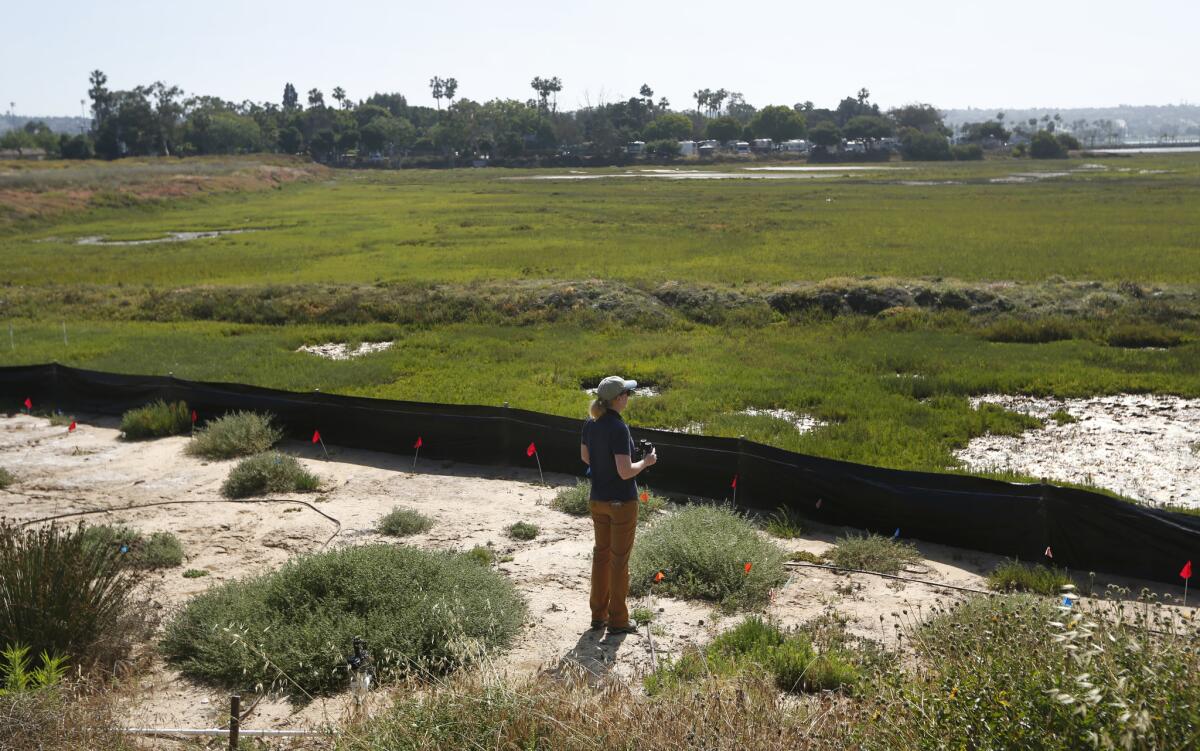Little-known Mission Bay marsh could be key to fight against San Diego’s rising sea levels

- Share via
San Diego’s iconic Mission Bay is mostly known for zooming jet skis, gliding sailboats, resort hotels and SeaWorld, but a small, fenced-off corner could be key to the city’s future.
Environmental concerns, including rising sea levels that threaten coastal housing, could be alleviated if the city is able to significantly expand 65 acres of marshland in the bay’s northeast corner.
Marshland boosts water quality, restores habitats, filters carbon dioxide from the air and can act as a sponge to mitigate rising sea levels. It also bolsters many species of birds that connect marine life with land-based animals and plants.
The 65 acres, known as the Kendall-Frost Marsh in honor of two families who had the foresight to preserve the area decades ago, is fenced off because it’s home to many threatened animals, plants and other wildlife. It’s open to the public just one day a year.
The area could be a key starting point in plans to restore as many as 240 acres of wetlands in 4,500-acre Mission Bay, which was all a giant marsh until dredging after World War II transformed it into the world’s largest aquatic park.
But environmental groups and city officials have struggled to reach consensus on how many acres should be restored to marshland and how they should be configured.
The debate was prompted by the sudden availability of the 50-acre Campland on the Bay site, which is at the end of its long lease, and a 76-acre mobile home park that recently reverted to city control.
City officials also included the 46-acre Mission Bay golf course in their study, which means some or all of that could eventually become marshland.
In April, the local chapter of the Audubon Society unveiled three scenarios that would give marshland the majority of the new acreage. Those scenarios conflict sharply with three significantly more recreation-oriented proposals that city officials unveiled in November.
With the city is scheduled to release revised proposals later this month that might feature more marshland, Rebecca Schwartz Lesberg, conservation director for the local Audubon Society, said last week that it’s important to remember how small the disputed area is in relation to all of Mission Bay.
“We talk about balance ... between recreation and wetlands, but this planning area doesn’t exist anywhere except lines on a map,” she said.
“What we really should be talking about is balance in the bay — how this project can help correct this really strong imbalance we have in Mission Bay that has for so long favored commerce and recreation at the expense of the environment.”
City officials have said their proposals are balanced because each envisions the entire Campland on the Bay site being restored to marshland, in addition to small portions of De Anza Point.
That means a minimum of 37.5% of the study area would be restored to marshland under the city’s proposals.
The Audubon Society, however, revised its proposals for wetlands restoration upward in April because of growing concerns about rising sea levels.
Lesberg said that was the only way to come close to meeting the long-term goal of the Mission Bay Park Master Plan for 120 acres of marshland.
Their scenarios call for as much as 240 acres of marshland now so that there will be an estimated 120 acres in 2100, when the California Coastal Commission says sea levels could rise by as much as 5 1/2 feet.
Lesberg said that any newly restored marshland wouldn’t have to be fenced off like Kendall-Frost, primarily because there would be more of it.
“This is an amazing resource, but it’s so small and fragile that they have to keep people out,” she said. “If it was larger and healthier and stronger we could have boardwalks, overlooks and a nature center.”
See the most-read stories in Local News this hour »
Lesberg said it’s frustrating that the public can tour the site only one day a year in February. The rest of the year the marsh is used by students and scientists to study salt marsh ecology and practice field research techniques.
“There are people who live one block away who have no idea there is a wetlands here,” she said.
On the other hand, Lesberg said, the city would be much worse off without its existing wetlands.
“If this had all been destroyed and we had to start from nothing, our chances of success would be much lower than with what we have — an existing marsh that we can expand,” she said.
The Audubon Society, which calls its proposals for the bay’s northeast corner “Rewild Mission Bay,” is scheduled to release cost estimates and other details in July.
City officials say they hope to begin environmental analysis of potential redevelopment within a year, with final approval from the City Council and the California Coastal Commission possible in 2019.
david.garrick@sduniontribune.com
Garrick writes for the San Diego Union-Tribune.
ALSO
World leaders close ranks on climate change: ‘Paris agreement cannot be renegotiated’
More to Read
Sign up for Essential California
The most important California stories and recommendations in your inbox every morning.
You may occasionally receive promotional content from the Los Angeles Times.













